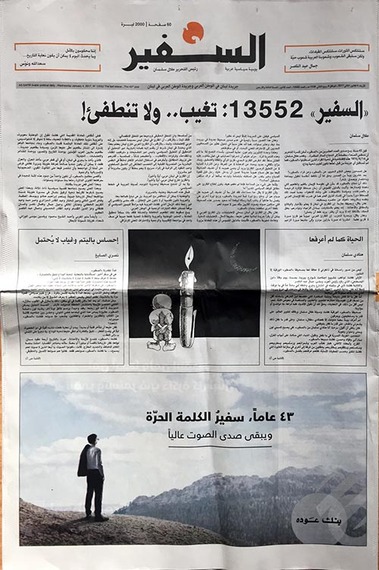
By Magda Abou-Fadil – Huffington Post
Assafir
finally bit the dust following a protracted battle with a metastasized
sickness that is afflicting most of Lebanon’s newspapers. “Assafir 13,552: Absent…Not Extinct,” was the front page
headline of a special 60-page mega issue on January 4 chronicling the
paper’s milestones and featuring bittersweet farewells from many of its
journalists and contributors over the years.
The 43-year-old
daily had gone into remission a few times with repeated infusions of
funds from assorted patrons when faced with bankruptcy, but succumbed to
the Grim Reaper hovering over the country’s print media on December 31,
2016. “The nation without Assafir“ was that day’s headline above a cartoon of a tearful dove (part of the paper’s logo) and a broken pen.
It couldn’t
have come at a worse time for staffers who hadn’t been paid in over a
year like hundreds of counterparts in other newspapers, and as the
industry goes into a dizzying free-fall. Although
founder and editor-in-chief Talal Salman had announced his intention to
close shop in 2016, he reversed his decision and kept limping along
until he said it was too costly to keep the paper going.
Last year he
also said he’d lay off about 50 staffers and cut journalists’ hours to
allow them to look for other jobs but they threatened to stage a sit-in
fearing they’d lose benefits by working shorter shifts. “This is where I
learned the letter, the profession and the soul of journalism, and
still do,” wrote veteran reporter Saada Allaou nostalgically in the
special issue recalling her modest beginnings in an impoverished
northern town and her move to Beirut where she had studied journalism
and longed to join Assafir’s ranks.
The paper had reinforced her leftist credentials, Arabism, and support for the Palestinian struggle, she added. Salman had launched Assafir
in 1974 as a platform for pan-Arab nationalist causes, with Egypt’s
late leader Gamal Abdel Nasser as his role model, and remained its
editor-in-chief until its demise. Its motto was “The Voice of the Voiceless.”
While it hosted
a who’s who of Lebanese and Arab writers from politicians to militia
leaders (during and after Lebanon’s 15-year civil war), poets,
activists, intellectuals and artists, the paper remained a family
business run by Salman and his children.
As with most
Lebanese papers, circulation, sales and advertising revenue were never
enough to sustain operations, so there was always a need for
benefactors.
In Assafir’s
case, initial funding came from Libya and the Palestine Liberation
Organization, to be followed by support from Saudi Arabia, Kuwait, the
United Arab Emirates, Qatar and the late billionaire prime minister
Rafic Hariri who was assassinated in 2005, according to a 2008 Wikileaks
cable.
In 2011, Salman
hooked up with a Syrian-American businessman who reportedly invested $7
million to keep the daily afloat but the partnership eventually fizzled
and gradual budget cuts led to a reduced and diminished product.
In recent
years, Salman also tried to secure funds from another rich former prime
minister, Hezbollah, and a former cabinet member with ties to a wealthy
Lebanese expat, to no avail.
As money got
tighter and management issues caused internal frictions, reporters and
editors began jumping ship or were indirectly pushed out.
Critics within
the ranks said the Salmans had enough money to save the paper and jobs
but decided to cut their losses and be done with it.
While enjoying a
relatively wider margin of press freedom than in neighboring countries,
Lebanese journalists have nevertheless been constrained by political,
religious, sectarian and other influences, leading to varying degrees of
censorship, self-censorship, and confrontations with local and foreign
adversaries.
Salman survived an assassination attempt in 1984 and Assafir’s printing presses were blown up in 1980.
It eventually resumed operations but threats continued to lurk around the corner.
Politicians and journalists from competing dailies weren’t so lucky, and Assafir diligently documented their targeting over the years.
But there was more than the politics, financial woes and violence that plagued the paper.
“No to the
electronic drowning,” wrote Assem Steitieh referring to the shift to
online and mobile news that had become the rage, saying the latter were
acceptable adjuncts to, not replacements of, print newspapers.
Therein lies one of Assafir’s biggest setbacks. It never transitioned smoothly into the 21st century.
“Cyberspace isn’t infinite and Assafir
can, and is qualified to, shed light on it, rather than become
extinguished in this sad manner,” wrote Sateh Noureddine, one of the
paper’s former editors who went on head Al Modon, an online publication, in an open letter to Salman.
The older Salman is rather traditional and although Assafir
had a website, it was two-dimensional, not really interactive, and one
didn’t sense there was engagement with its readers through social media
or other means, notably the millennial and younger generation.
In a melodramatic video posted on YouTube,
Salman is seen signing off with a fountain pen, donning a woolen scarf,
turning off the lights and walking out of his office as his desk lamp
nervously flickers on and off and a singer is heard belting out a tune
in the background.



